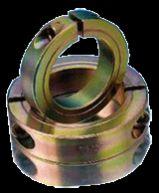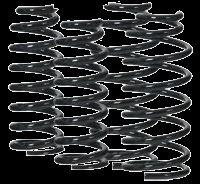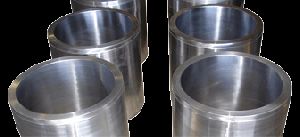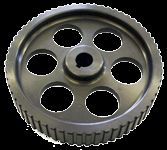
plating
Zinc plating is identical to electro galvanizing in principle in that both are electrode position processes. Zinc plating is used for coatings deposited on small parts such as fasteners, crank handles, springs, and other hardware items. The zinc is supplied as an expendable electrode in a cyanide, alkaline non-cyanide, or acid chloride salt solution. Cyanide baths are the most operationally efficient, but they potentially create a pollution and hazardous material problem.After alkaline or electrolytic cleaning, pickling to remove surface oxides, and rinsing, the parts are loaded into a barrel, rack, or drum and immersed in the plating solution. Various brightening agents may be added to the solution to add luster, but careful control of the bath and brightener is needed to ensure a quality product. Post-plating treatments may be used to passivate the zinc surface and at the same time impart various translucent colors to the coating. These post-plating treatments may be used to provide a desired color or to extend the life of the plated coating.The normal zinc-plated coating is dull gray in color with a matte finish, although whiter, more lustrous coatings can be produced, depending on the process or agents added to the plating bath or through post-treatments. The coating is thin, ranging up to 1 mil (25 µm), restricting zinc-plated parts to very mild (indoor) exposures. ASTM Specification B 633 lists four classes of zinc plating: FeZn 5, FeZn 8, FeZn 12 and FeZn 25. The number indicates the coating thickness in microns. The coating finds application in screws and other light fasteners, light switch plates and other small parts. Materials for use in moderate or severe applications must be chromate conversion coated.
...more
Industrial Zinc Plating
Zinc plating is identical to electro galvanizing in principle in that both are electrode position processes. Zinc plating is used for coatings deposited on small parts such as fasteners, crank handles, springs, and other hardware items. The zinc is supplied as an expendable electrode in a cyanide, alkaline non-cyanide, or acid chloride salt solution. Cyanide baths are the most operationally efficient, but they potentially create a pollution and hazardous material problem.After alkaline or electrolytic cleaning, pickling to remove surface oxides, and rinsing, the parts are loaded into a barrel, rack, or drum and immersed in the plating solution. Various brightening agents may be added to the solution to add luster, but careful control of the bath and brightener is needed to ensure a quality product. Post-plating treatments may be used to passivate the zinc surface and at the same time impart various translucent colors to the coating. These post-plating treatments may be used to provide a desired color or to extend the life of the plated coating.Coating CharacteristicsThe normal zinc-plated coating is dull gray in color with a matte finish, although whiter, more lustrous coatings can be produced, depending on the process or agents added to the plating bath or through post-treatments. The coating is thin, ranging up to 1 mil (25 µm), restricting zinc-plated parts to very mild (indoor) exposures. ASTM Specification B 633 lists four classes of zinc plating: Fe/Zn 5, Fe/Zn 8, Fe/Zn 12 and Fe/Zn 25. The number indicates the coating thickness in microns. The coating finds application in screws and other light fasteners, light switch plates and other small parts. Materials for use in moderate or severe applications must be chromate conversion coated.The coating is entirely pure zinc, which has a hardness about one-third to one-half that of most steels.
...more
Hard Chrome Plating
Hard chrome, also know as industrial chrome or engineered chrome, is used to reduce friction, add wear resistance, or increase corrosion resistance. it is very hard, measuring between 66 to 70 HRC. Hard chrome tends to be thicker than the decorative treatement, typically ranging from 0.075 to 0.25 milimetre (0.0030 to 0.0098 in), but can range from 0.005 to 0.01 mil (0.00013 to 0.00025 mm). Surface defects and roughness are amplified, because hard chrome does not have a leveling effect. Hard chromium plating is subject to different types of quality requirement depending on the application, for instance, the plating on hydraulic piston rods are tested for corrosion resistance with a salt spray test.
...more
Hard Anodizing
CHETANA is a job shop where we do Hard Anodizing as per customer's requirement. We are and ISO 9001 - 2000 company.Hard Anodizing is an electrolysis process in which the coating is deposited by Alloys of aluminium a layer of aluminium oxide are produced. Hard Anodizing produces thicker and harder coatings from 25 microns to 100 microns. Hard Anodizing is used for technical purposes corrosion and wear resistance.In many of the application, we can use Hard Anodizing instead of Hard Chromium plating because it is generally cheaper to apply and presents fewer adhesion problems and will give better oil-retention properties than many types of chromium deposition. Environment : - Hard Anodizing is an environment friendly process, relatively safe. No extra ordinary precautions are needed to ensure worker safety and environmental hazards. Colour : - Hard Anodizing is typically oxidation of aluminium and its alloys. Controlled oxidation of these alloys determine the colour of the Component. It offers the following advantages: Totally uniform thickness on the entire part Coating thickness that can be controlled in micron tolerances. Non-poisonous and colorless in nature,eco- friendly process. Low working cost. Stability. Hard anodizing has unique combination of engineering properties and is widely used for : High surface hardness, 350 VHN to 850 VHN Very good adhesion to base material. High corrosion and wear resistance. Heat dissipation. Can achieve salt spray resistance in excess of 1000 hours. Close dimensional control after coating. Decorative appearance. Low specific gravity High mechanical strength. Some Application of Hard Anodizing :Manufacture :Valve body, cylinder housing, bearing, motor housing, transformer, motor body, shaft drive wheel, cog wheel, cylinder, piston, gear buffer, cover, hydraulic cylinders, aluminium pipes, spring cover, surgical splints, fan and nozzles, timing and mechanical computer gears, insulation plates and transmission parts.Vehicle :Break pistons, Valve body, fork tube rotor belt wheel, master cylinder, range cylinder, anti-lock, break assemblies, and rims.Pumps :Oil and fuel pumps, housings, impellers, diffuser, fittings, lid, bushing, pistons, membrane lid, shaft, slide valve.Packing :Gauges, cylinder, roll, forming pad, pallet, link, flap. Plastic :Weld pad, forming tools, cores, feeding screw, press pad. Food Stuffs :Frying pan, knife, baking plate, funnel, scraper, tube.Aircraft :Shield, driving housing, cog wheel
...more
Electroless Nickel Plating
“ PEPCOAT ” is the trade name of our quality phosphorus- Nickel metal alloy coating. We undertake coating of customer parts ranging from small fasteners to large rollers and Chemical Equipment.A New and unique Engineering Plating Chetana is a Job shop where we do Electroless Nickel plating on customer parts equipment, We are the pioneers in this field and besides being the most experienced, have one of the largest plating facilities in India. Our plating – called “ PEPCOAT ” and technically known as Electroless Nickel – is an unusual plating because it does not have the handicaps of conventional Electroplating, and offers the following :
...moreBe first to Rate
Rate ThisOpening Hours